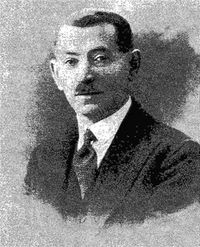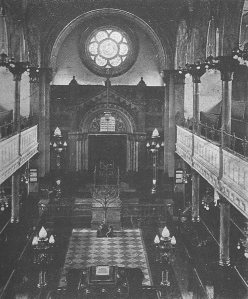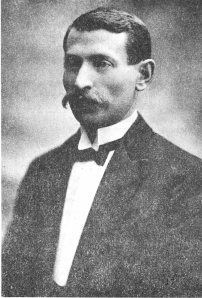Although Samuel Alman is considered by many as the greatest ‘English’ composer of synagogue music, he was not born in this country. He hailed from Sobolevka, Podolia, in Russia and studied music at the Odessa and Kishnev conservatories. After conscription, he served as a musician in the Russian army for four years and after completing his service, the terrible pogrom that he witnessed at Kishnev (1903) encouraged him to come to London. In England, he continued his musical studies at the Royal College of Music.
It was not long before Alman was drawn into the Jewish life of London and he was soon appointed as Choirmaster at the Dalston Synagogue.
In the course of time he also became Choir leader of the Great Synagogue, in Duke’s Place as well as at Hampstead.
Although he composed a great deal of liturgical music, there are only a few of his pieces that are known now. They were certainly utilised in the Synagogues where he worked and a number of his compositions he dedicated to various Chazanim, such as Halter, Shechter and Boyars.
Alman was the leader of the Halevi Choral Society and the London Hazzanim Choir. He was a prolific composer of many diverse works; a string quartet, pieces for piano and organ, Hebrew Art songs, and arrangements of Yiddish songs. In 1912, his opera Melech Ahaz (King Ahaz) was performed for the first time, though it now seems to have lapsed into oblivion.
In 1925 and 1938 Alman published Shirei Beit ha-Knesset, 2 vols, which is his collection of Synagogue music for cantor and choir. Volume one contains the pieces that are still most well-known amongst his compositions, Yehi Ratson – for Blessing the New Moon, and the sublime Hinenei and Ribono Shel Olam for Sefirat HaOmer. Although many Ba’alei Tefilla sing the Yehi Ratson unaccompanied, it really does require the responses of a Choir to achieve what the composer actually intended!
In 1933, Alman was called upon to update the so-called ‘Blue Book’ – The Voice of Prayer and Praise, that had first been published in 1899. This is subtitled, ‘A Handbook of Synagogue Music’ and was originally intended for use by the congregation, who would use it to follow the singing.
When Alman updated it, he added a supplement which contained many of his own compositions, including Birkat Cohanim and Havu laShem (Psalm 29).
Although Samuel Alman undoubtedly had a great influence on the music used in the main London Synagogues during his lifetime, with the demise of interest in the style of service that requires a Chazan and choir, which forms the bulk of Alman’s compositions for the Synagogue, it’s sadly inevitable that most of his music is destined to become lost, with only the popular pieces being used in concerts.
Alman was the leader of the Halevi Choral Society and the London Hazzanim Choir. He was a prolific composer of many diverse works; a string quartet, pieces for piano and organ, Hebrew Art songs, and arrangements of Yiddish songs. In 1912, his opera Melech Ahaz (King Ahaz) was performed for the first time, though it now seems to have lapsed into oblivion.
In 1925 and 1938 Alman published Shirei Beit ha-Knesset, 2 vols, which is his collection of Synagogue music for cantor and choir. Volume one contains the pieces that are still most well-known amongst his compositions, Yehi Ratson – for Blessing the New Moon, and the sublime Hinenei and Ribono Shel Olam for Sefirat HaOmer. Although many Ba’alei Tefilla sing the Yehi Ratson unaccompanied, it really does require the responses of a Choir to achieve what the composer actually intended!
In 1933, Alman was called upon to update the so-called ‘Blue Book’ – The Voice of Prayer and Praise, that had first been published in 1899. This is subtitled, ‘A Handbook of Synagogue Music’ and was originally intended for use by the congregation, who would use it to follow the singing.
When Alman updated it, he added a supplement which contained many of his own compositions, including Birkat Cohanim and Havu laShem (Psalm 29).
Although Samuel Alman undoubtedly had a great influence on the music used in the main London Synagogues during his lifetime, with the demise of interest in the style of service that requires a Chazan and choir, which forms the bulk of Alman’s compositions for the Synagogue, it’s sadly inevitable that most of his music is destined to become lost, with only the popular pieces being used in concerts.
Our subject was the sixth in a family of fourteen. He was born at Sobolevka, in the Province of Podolia, or Kamenetz, in “White Russia”, north of Bessarabia. His father, Reb Nachum, was a noted Talmudist and a fine musician. His mother, Sara Batya, was the only daughter of the local Rav, and a gifted writer of poetry.
As was, and still is, the practice, Zemirot were sung at the Sabbath table, and Samuel’s performances, even at the age of four, were already outstanding. From the age of five, he sang in the local Synagogue choir for the Yamim Noraim, and aroused the admiration of the Congregation, whose influence soon made him a soloist. He became known as “The Singing Child of Sobolevka”, and, at the age of ten, was taken by his mother to a neighbouring town, where there was a choir of men and boys who sang from musical notation. Alman soon became able to read music.
At the age of seventeen, he went to the Odessa Conservatoire, began to study music seriously, and there composed Synagogual Music. He was also an excellent Talmudical scholar. He then went to the Kishinev Conservatoire, having previously been conscripted into the Russian Army, where he played in a military band. Following the infamous “Kishinever Pogrom” in 1903, he left for London, and studied at the Guildhall School of Music. Alman had one uncle resident in London, and it is probable that it was for this reason that he came to England.
While at Kishinev, he was strongly influenced by the Chazanut of Razumny, and, throughout his life, strove to bring a sense of tradition, musicality and professionalism to his elected craft. His Chazanut was deeply adherent to the Southern Russian Cantorial tradition, and he owed a great deal to the choral technique of the “M’Shorarim” (choristers), as heard in the works of other leading Synagogual composers. He was an innovator of the “Art Nouveau” in music – and was strongly swayed by the compositions of Claude Debussy, the “Impressionistic Style”. Nevertheless, he succeeded in preserving the melodic features of the Eastern European Ashkenazi chant, often creating a mystic atmosphere.
After his arrival in London, five years in fact, he obtained his ARCM at the Royal College of Music, although not a student there. He was preparing for his Doctorate in music, but the first World War interrupted his studies. His first position as a Synagogue Conductor began in 1906-7, at the Great Synagogue, Duke’s Place, at a time when Chazan Katz was the First Reader. Alman loved lyrical music, and wrote the beautiful “Sheva Berachot” for Katz, since he was an ‘effortless Chazan’. He also wrote an alto solo for the youthful Mark Raphael (eleven at the time) comprising “Hashkiveinu”, but this was vetoed by the Chief Rabbi, on the grounds that Raphael was too young, and the part was eventually given to the tenor, Dubin, much to young Mark’s disappointment!
His home life was simple: not for Alman the secluded studio. His brother’s house in the East End contained a piano, and when Samuel visited him, would share a corner of his sister-in-law’s kitchen table, as she made ‘lokshen’ and other culinary delicacies. As the distinguished singer and singing teacher, Mark Raphael recalls, ‘he could write on a bus’. Alman worked on many of his most intricate compositions in the most inappropriate places – as long as he could write.
In 1911-12, he composed the first Yiddish Grand Opera, which he based on a mythical story, set in the reign of King Ahaz, son of Jotham (circa 732, B. C. E). He must have given full reign to his imagination, for there are no Biblical, Midrashaic or Talmudic sources.
The preliminary performances were at “The people’s Palace”, in Mile End, and were subsidised by the poor Jewish artisans scraping together their pennies. In addition to a microfilm copy in the possession of one of his nieces, Mrs. Gertrude Hardie, the complete manuscript is in the library of the Hebrew University, Jerusalem. The important fact is that this was specifically written as a Yiddish Opera. Alman was subsequently to translate and arrange versions of famous operas, including “Faust”, “Rigoletto”, “Cavalleria Rusticana”, all in Yiddish.
The Yiddish Grand Opera “King Ahaz” toured many places, but the London performances were at the grandiose-titled “Temple of Arts” in Commercial Road. Alas, this enterprise of bringing culture to poor Yiddish immigrants, was unsuccessful, and the “Temple” became a cinema, known as “The Palaseum”. The Opera, however, was well received Iy the critics.
Alman was a prolific composer and conductor. He orchestrated “Eli, Eli” for Chazan Sirota, and conducted Synagogue Musical concerts at the Queen’s and Royal Albert Halls, in 1911-12. He often invited Chazan Rosenblatt to his home in Brondesbury, and they spent many hours discussing music. Alman’s major works included the whole of the Sabbath Service “Shirei Bet Haknesset”. The first volume, issued by a Berlin publisher in 1925, was for Cantor and Choir, and contained fifty-five pieces. : The second volume was produced by the Oxford University Press in 1938, and contained ninety-seven pieces for the Yaniim Noraim. In 1915, he had composed a setting of Psalm fifteen for chorus and piano, and “Mi Addir” and “Sheva Berachot” for Cantor and Organ. In 1930, he edited “Shirei Razuniny”.
The second volume of “Shirei Bet Haknesset”, mentioned above, contained a very brief auto-biography: he had served the Hampstead Synagogue for twenty-two years, and had set to music, the poems of Bialik, Zalman Schneiur, Katznelson, Raisin, Kahan, Tchernichovsky, among many others. He had made arrangements of Yiddish folksongs and compositions. Alman could also write semi-secular works, such as the “Ebraica Quartet Suite” of 1932. “Eleven short pieces for the Organ”, a Cantorial composition for male choir, was published by the Ministers/Chazanim of Great Britain in 1934, and issued by the late M.L. Cailingold, price two shillings!
Alman followed the Chazanut of Nissi Belzer and Yerucham Hakaton (not Bezallel, as some biographers would have it). He founded the “Halevi Choral Society”, which performed only Hebrew and Yiddish compositions, most of them, his own. He also conducted the London Chazanim Choir with great success. In 1928, Alman arranged and conducted in the “Jewish Chronicle Musical Festival”, in the Kingsway Hall. In 1929, a recital of his music was given at the Wigmore Hall, with Mark Raphael as soloist. This was a great success. In fact, it was the first time that Hebrew Music was performed in the Wigmore Hall. In 1932, Wolf Lewi gave another recital in the Wigmore Hall, where the “Ebraica Quartet” was performed.
Alman gave many lectures on Jewish Music. His last lecture was during the second World War to Jewish members of the forces, with illustrations by Chazan Gershon Boyars, under the title “How to listen to the Chazan”. The then Chief Chaplain to the Jewish Forces, Chief Rabbi Sir Israel Brodie, invited Alman to repeat his lecture, but this was not possible owing to Alman’s illness.
Idelsohn, in his “Jewish Music” published in 1948, states: (of Alman) “His aims were not to furnish his compositions with foreign forms as the Western Chazan did not to corrupt the Jewish tunes, but to set them to modern harmony”.
Alman’s genius made his services greatly sought after; he served as choirmaster in the Great Synagogue, Duke’s Place, in the Dalston Synagogue, Poet’s Road, and, of course, in the Hampstead Synagogue. Rumour also has it that he served, for a time in the Philpot Street Great Synagogue, in his early days as a choirmaster. Being an orthodox Jew, he would pace the not inconsiderable distance between his home in Brondesbury and Dennington Park Road, West Hampstead on Sabbaths and Festivals. He was a calm, patient teacher, and assisted many singers and Chazanim with their requirements. He also gave ‘private lessons’. He hated histrionics, and his idea of Chazanut, was a dignified stance, without ‘shokeling’, or other undignifled movements.
An incident in which Alman was involved with showmanship occurred when the late Chazan Leib Glantz visited London just after the War, about 1946. Glantz was a ‘Chazan’s Chazan’, whose art – almost like that of the surrealist artist Salvador Dali, had to grow upon one. One either adored his Chazanut or hated it ! Nevertheless, he was a “World Chazan”, and his two concerts in London, attracted packed Synagogues. The first was in the “Machzikei Hadass” in Brick Lane, and the second in “Grove Lane” (Lampard Grove). At the first “Maariv Concert” he was brilliant, but his listeners were unaccustomed to his style. In the second, they were slightly better adjusted.
Glantz was either unaware of Alman’s dislike of histrionics, or did not care. He indulged in many ‘undignified movements’. In the second “Maariv Concert” in Grove Lane, his ecstacy on the Bima did not meet with Alman’s approval, but, since the Chazan was on his Bima, and the choir and Alman were on the floor, in front of the Aron Hakodesh, Alman could do nothing, although he was seething His moment came, when Glantz came down from the Bima, reciting ‘Aleinu’, and, at the very end, flung out his arms in supplication – a spontaneous gesture. As he did this, his biretta fell off. Without giving Glantz time to retrieve it, Alman seized the hat, and jammed it onto Glantz’s head: “Na’…”
Alman’s life spanned the careers of many Chazanim: he was particularly fond of Chazan Boyars, who had been his colleague for so many years. He was a prolific and stylish writer of Yiddish prose, a gift which he had inherited from his mother, who was especially adept in writing rhyming couplets in her letters from Russia. He contributed many interesting and informative articles to “Die Chazonom Velt”, a Cantors’ Magazine in Yiddish, which was edited by Chazan Pinchas Sherman, the Chazan Sheni in the Tlomazke Synagogue of Warsaw, from 1933 to the holocaust.
In one splendidly written article (in the December 1933 issue) Alman, speaking of the duties which an English Jew expected from his Chazan, stated that the Chazan was required to be possessed of a perfect “Perush Hamilot”; he must rise each morning to lead the prayers at seven; he must read the Torah at least twice weekly, must visit hospitals, and commiserate with the Jewish sick, must also, from time to time, visit his congregants socially in their homes. “One often hears”, wrote Alman, “from the President of a Synagogue, the words: ‘We seek a Chazan who should be fifty per-cent Chazan and fifty per-cent “Mensch”.
Samuel Alman married his first cousin, Celia Ohrman in 1905, Who survives him. He died in 1947. Theirs was a childless marriage, and, although he left no heirs, what he did leave, however, was a host of admiring, disconsolate and sorrowing Chazanim and singers, who appreciated his lifelong work for the Service of the Synagogue, and who perform his compositions to this day.
The writer is particularly grateful to Samuel Alman’s niece, Mrs. Gertrude Hardie, Mr. Mark Raphael, the distinguished music teacher, and Chazan P.C. Faigenbium, for their unstinting assistance in the preparation of this biography.



